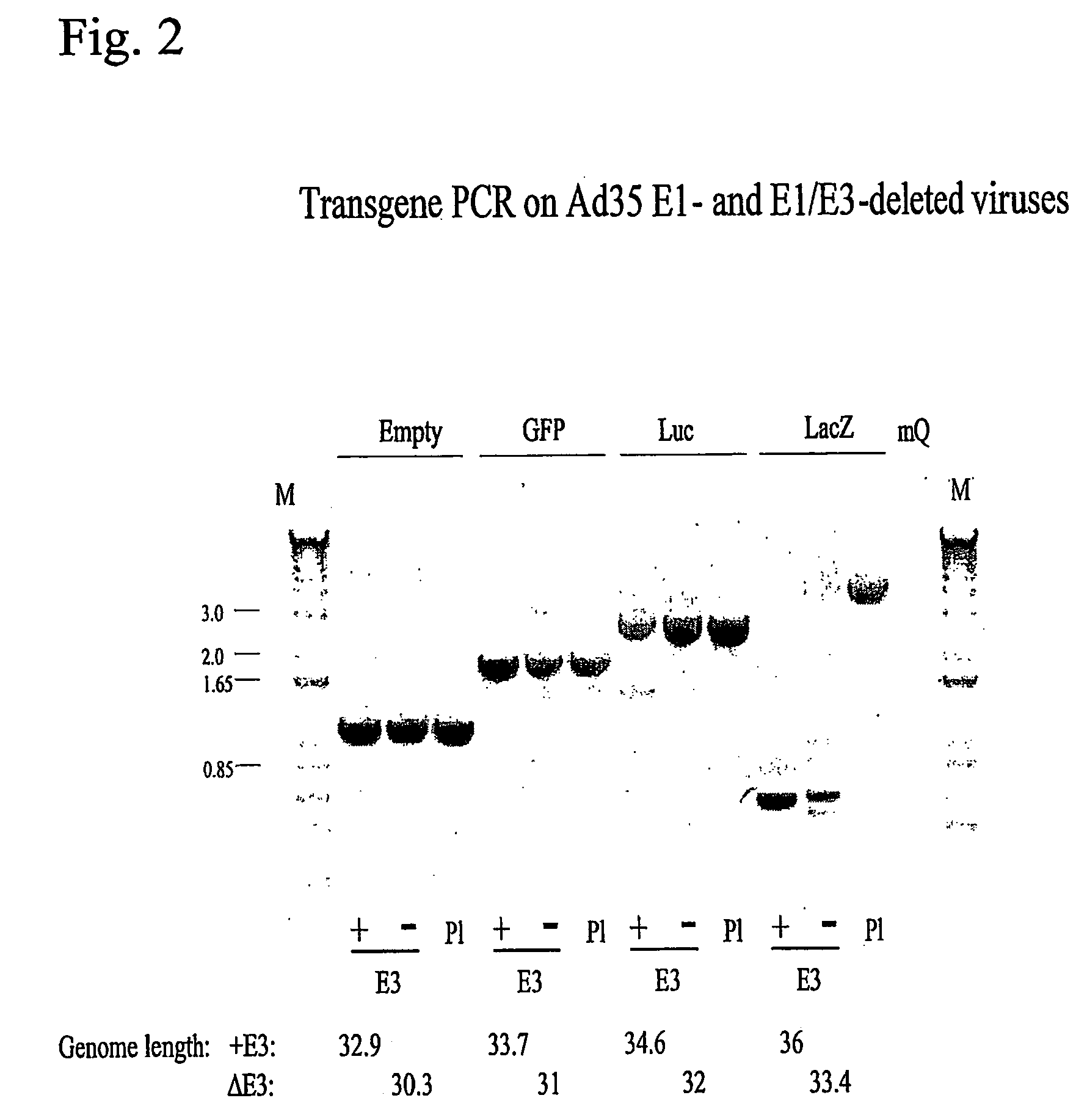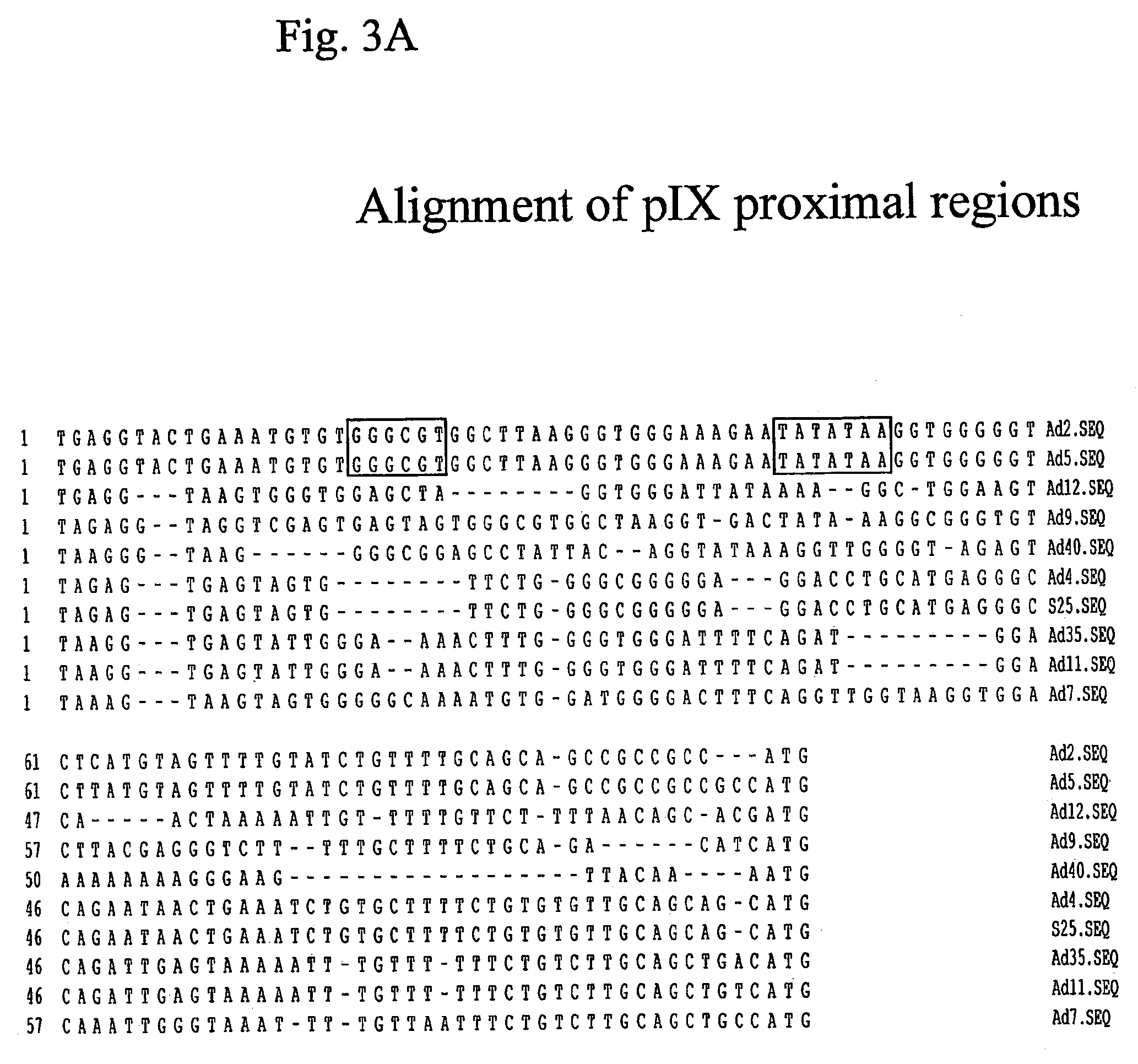Stable adenoviral vectors and methods for propagation thereof
a technology of adenoviral vectors and vectors, applied in the field of biotechnology and medicine, can solve the problems of reducing the stability of pix-minus virions, reducing the transduction efficiency in vivo, and depleting the effect of exogenous sequences
- Summary
- Abstract
- Description
- Claims
- Application Information
AI Technical Summary
Benefits of technology
Problems solved by technology
Method used
Image
Examples
example 1
PER.C6™-Based Complementing Cell Lines for E1-Deleted Ad35 Viruses
[0097]PER.C6™ cells were seeded in 10 cm culture dishes at a density of 3×106 cells / dish in PER.C6™ culture medium (DMEM (Gibco BRL) complemented with FBS (Gibco BRL) up to 10% and 10 mM MgCl2 (4.9 M stock solution, Sigma)). Two days later, nine dishes were transfected with 1 μg ScaI linearized pIG35.55K DNA (described infra) and nine dishes were transfected with 1.5 μg ScaI linearized pIG35.55K DNA. Separate control dishes were transfected with 1 or 1.5 μg ScaI linearized pAdApt35.LacZ (described in WO 00 / 70071) to monitor transfection efficiency and with 1 or 1.5 μg ScaI linearized pcDNA.nlsLacZ. pcDNA.nlsLacZ (described in WO99 / 55132) is a pcDNA3-based plasmid (Invitrogen) with the nlsLacZ gene driven by the CMV promoter. pcDNA.nlsLacZ also contains a neor-expression cassette. As a negative control, one extra dish was transfected with linearized pAdApt35.LacZ, a construct that lacks the neor-selection gene. All tra...
example 2
Generation of pWE.Ad.pIX-rITRΔE3
[0103]The early region-3 of human adenoviruses contains multiple coding regions for proteins that interfere with the host immune response to adenoviral infection. When adenoviral vectors are used as vaccine carriers, such interference is unwanted. Therefore, we constructed an Ad35 backbone cosmid lacking the E3 region.
[0104]Hereto, construct pBr.Ad35.PRn (FIG. 15; described in Example 13 in publication EP1054064) was digested with StuI and MluI and the 17.3 kb vector fragment was purified from low melting-point (LMP) gel using agarase enzyme (Roche) according to the manufacturer's instructions. Next, a PCR fragment was generated on pBr.Ad35.PRn using primers 35E3for and 35E3rev. For the amplification Pwo DNA polymerase (Roche) was used according to the manufacturer's instructions and program set at 94° C. for two minutes, 30 cycles of (94° C. for 30 seconds, 58° C. for 30 seconds and 72° C. for one minute) and a final incubation at 68° C. for eight mi...
example 3
Limits in Packaging Size of E1-Deleted Ad35-Based Vectors
[0106]Ad35-based E1-deleted and E1 / E3-deleted vectors containing different inserts were generated by transfection of PER55K-clone #16 cells (see Example 1) with:
[0107]1.5 μg of an Ad35 adapter plasmid carrying a specific transgene digested with PacI or pIPsp-1 enzyme to liberate the adenovirus insert from the plasmid vector sequences and,
[0108]0.5 μg of either pWE.Ad35.pIX-rITR digested with NotI or with pWE.Ad35.pIX-rITRΔE3 digested with NotI enzyme.
[0109]The right flank of the adapter plasmids and the left end of the backbone plasmid contain homologous sequences mediating recombination events that lead to a complete E1-deleted viral genome (as described in WO 00 / 70071).
[0110]Transfections were done with 30 μl Lipofectamine reagent (Invitrogen / Life Technologies) for each set of constructs according to the manufacturer's instructions. Transfection mixtures were added to PER55K clone 16 cells at 70% confluency in T25 flasks. Th...
PUM
| Property | Measurement | Unit |
|---|---|---|
| concentration | aaaaa | aaaaa |
| volume | aaaaa | aaaaa |
| volume | aaaaa | aaaaa |
Abstract
Description
Claims
Application Information
 Login to View More
Login to View More - R&D
- Intellectual Property
- Life Sciences
- Materials
- Tech Scout
- Unparalleled Data Quality
- Higher Quality Content
- 60% Fewer Hallucinations
Browse by: Latest US Patents, China's latest patents, Technical Efficacy Thesaurus, Application Domain, Technology Topic, Popular Technical Reports.
© 2025 PatSnap. All rights reserved.Legal|Privacy policy|Modern Slavery Act Transparency Statement|Sitemap|About US| Contact US: help@patsnap.com



